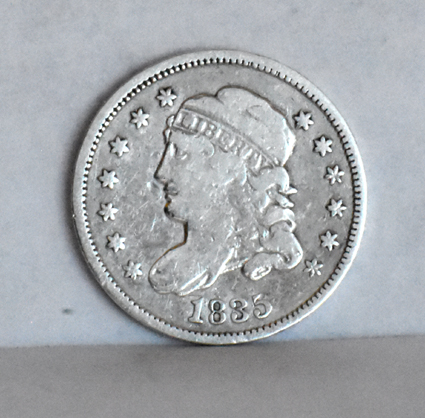Capped Bust Half Dime
1829 to 1837
 |
Only two years after the first cent and half cent coins were minted in the United States, a half dime was designed and produced. The first issue carried the 1794 date but was actually released in circulation in 1795. This first design was made of almost 90% silver, alloyed with copper, and carried the liberty with flowing hair image on the obverse, the other side displaying a standing eagle. In 1796 the obverse portrait was replaced by the draped bust and in 1800 the reverse side was altered by placing a shield over the middle of the eagle. These early half dimes were minted in small quantities and production was halted in 1805, with the result that all are scarce and quite valuable. When production of the Half Dime was resumed in 1829, the draped bust was replaced by the Capped Bust design and the eagle on the reverse was altered slightly by tipping the wings downward. This was the first version of the coin to be minted in large quantities and one which can be easily obtained today. |  |
| This coin is certified by PCGS as uncirculated but has been removed from its slab and is stored in the D case. This coin is worth about $300 | This is the reverse of the coin at left. | |
 |
When the Mint Act of 1792 was passed by congress, some 1500 'half dismes' were made. But only about 200 to 250 of these survive today and about 10% of those are uncirculated. The five cent coin was first called a 'half disme' due to the adaptation of the decimal system in 1786 and 1787 and the French translation of the decimal system, La Disme. The 'art of tenths' eventually traveled to England and then to America and finally morphed into Dime. But the five cent coin did not become a 'nickel' until about 1865 when that metal was finally introduced as a large component of the alloy used to mint these coins. Earlier attempts to do so had met with failure due to die wear and breakage of the resulting coins. But success was realized when bronze was used instead of copper for the mix of metals. The 1792 half disme is extremely valuable, especially the uncirculated examples, and in 2013 one of those sold at auction for $1.4 million. Circulated coins, when available, sell for $50,000 and up. |
 |
| This coin is AU (almost uncirculated) and is worth about $250. | This is the reverse of the coin at left. | |
 |
|
 |
| I have three of these half dimes. The one above is worth about $80. | This is the reverse of the coin at left. |
| 1835: January 30: Richard Lawrence unsuccessfully tries to assassinate President Andrew Jackson in the United States Capitol; this is the first assassination attempt against a President of the United States. June 2: P. T. Barnum and his circus begins first tour of the U.S. July 4: The Baltimore and Ohio Railroad completed construction of its Thomas Viaduct, which was then the longest bridge in the United States, and second only to London Bridge in the world. August 25: The Great Moon Hoax begins. This was a series of six articles that were published in The Sun, a New York newspaper, beginning on August 25, 1835, about the supposed discovery of life and even civilization on the Moon. The discoveries were falsely attributed to Sir John Herschel, one of the best-known astronomers of that time. October 2: The Battle of Gonzales, part of the Texas Revolution: Mexican soldiers attempt to disarm the people of Gonzales, Texas but encounter stiff resistance from a hastily assembled militia. December 9: The army of the Republic of Texas captures San Antonio. December 16-17: The Great Fire of New York destroys 530-700 buildings and kills two. December 20: The Texas Declaration of Independence is first signed at Goliad, Texas. Fort Cass is established, the military headquarters and site of the largest internment camps during the 1838 Trail of Tears. The Trail of Tears was a series of forced relocations of approximately 60,000 Native Americans between 1830 and 1850 by the United States government. Thousands died before reaching their destinations or shortly after from disease. |